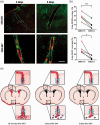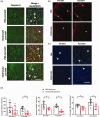Role of perivascular and meningeal macrophages in outcome following experimental subarachnoid hemorrhage
- PMID: 33444089
- PMCID: PMC8327101
- DOI: 10.1177/0271678X20980296
Role of perivascular and meningeal macrophages in outcome following experimental subarachnoid hemorrhage
Abstract
The distribution and clearance of erythrocytes after subarachnoid hemorrhage (SAH) is poorly understood. We aimed to characterize the distribution of erythrocytes after SAH and the cells involved in their clearance. To visualize erythrocyte distribution, we injected fluorescently-labelled erythrocytes into the prechiasmatic cistern of mice. 10 minutes after injection, we found labelled erythrocytes in the subarachnoid space and ventricular system, and also in the perivascular spaces surrounding large penetrating arterioles. 2 and 5 days after SAH, fluorescence was confined within leptomeningeal and perivascular cells. We identified the perivascular cells as perivascular macrophages based on their morphology, location, Iba-1 immunoreactivity and preferential uptake of FITC-dextran. We subsequently depleted meningeal and perivascular macrophages 2 days before or 3 hours after SAH with clodronate liposomes. At day 5 after SAH, we found increased blood deposition in mice treated prior to SAH, but not those treated after. Treatment post-SAH improved neurological scoring, reduced neuronal cell death and perivascular inflammation, whereas pre-treatment only reduced perivascular inflammation. Our data indicate that after SAH, erythrocytes are distributed throughout the subarachnoid space extending into the perivascular spaces of parenchymal arterioles. Furthermore, meningeal and perivascular macrophages are involved in erythrocyte uptake and play an important role in outcome after SAH.
Keywords: Perivascular macrophage; clodronate liposome; erythrocytes; inflammation; subarachnoid hemorrhage.
Conflict of interest statement
Figures







Similar articles
-
Subarachnoid hemorrhage distinctively disrupts the glymphatic and meningeal lymphatic systems in beagles.Theranostics. 2024 Sep 16;14(15):6053-6070. doi: 10.7150/thno.100982. eCollection 2024. Theranostics. 2024. PMID: 39346537 Free PMC article.
-
The sentinel against brain injury post-subarachnoid hemorrhage: efferocytosis of erythrocytes by leptomeningeal lymphatic endothelial cells.Theranostics. 2025 Jan 20;15(6):2487-2509. doi: 10.7150/thno.103701. eCollection 2025. Theranostics. 2025. PMID: 39990222 Free PMC article.
-
Perivascular Macrophages Mediate Microvasospasms After Experimental Subarachnoid Hemorrhage.Stroke. 2023 Aug;54(8):2126-2134. doi: 10.1161/STROKEAHA.122.042290. Epub 2023 Jun 16. Stroke. 2023. PMID: 37325921
-
A new perspective on cerebrospinal fluid dynamics after subarachnoid hemorrhage: From normal physiology to pathophysiological changes.J Cereb Blood Flow Metab. 2022 Apr;42(4):543-558. doi: 10.1177/0271678X211045748. Epub 2021 Nov 22. J Cereb Blood Flow Metab. 2022. PMID: 34806932 Free PMC article. Review.
-
Meningeal Multipotent Cells: A Hidden Target for CNS Repair?Neuromolecular Med. 2021 Sep;23(3):339-343. doi: 10.1007/s12017-021-08663-1. Epub 2021 Apr 24. Neuromolecular Med. 2021. PMID: 33893971 Free PMC article. Review.
Cited by
-
All Three Supersystems-Nervous, Vascular, and Immune-Contribute to the Cortical Infarcts After Subarachnoid Hemorrhage.Transl Stroke Res. 2025 Feb;16(1):96-118. doi: 10.1007/s12975-024-01242-z. Epub 2024 Apr 30. Transl Stroke Res. 2025. PMID: 38689162 Free PMC article. Review.
-
Hepcidin depending on astrocytic NEO1 ameliorates blood-brain barrier dysfunction after subarachnoid hemorrhage.Cell Death Dis. 2024 Aug 7;15(8):569. doi: 10.1038/s41419-024-06909-x. Cell Death Dis. 2024. PMID: 39107268 Free PMC article.
-
CD47 Blockade Accelerates Blood Clearance and Alleviates Early Brain Injury After Experimental Subarachnoid Hemorrhage.Front Immunol. 2022 Feb 25;13:823999. doi: 10.3389/fimmu.2022.823999. eCollection 2022. Front Immunol. 2022. PMID: 35281006 Free PMC article.
-
Peripheral macrophages in the development and progression of structural cerebrovascular pathologies.J Cereb Blood Flow Metab. 2024 Feb;44(2):169-191. doi: 10.1177/0271678X231217001. Epub 2023 Nov 24. J Cereb Blood Flow Metab. 2024. PMID: 38000039 Free PMC article. Review.
-
Microglial histone deacetylase 2 is dispensable for functional and histological outcomes in a mouse model of traumatic brain injury.J Cereb Blood Flow Metab. 2024 May;44(5):817-835. doi: 10.1177/0271678X231197173. Epub 2023 Dec 9. J Cereb Blood Flow Metab. 2024. PMID: 38069842 Free PMC article.
References
-
- Sandvei MS, Romundstad PlR, MüLler TommBrostrup, et al.. Risk factors for aneurysmal subarachnoid hemorrhage in a prospective population study: the HUNT study in Norway. Stroke 2009; 40: 1958–1962. - PubMed
-
- Macdonald RL.Delayed neurological deterioration after subarachnoid haemorrhage. Nat Rev Neurol 2014; 10: 44–58. - PubMed
-
- Rowland MJ, Hadjipavlou G, Kelly M, et al.. Delayed cerebral ischaemia after subarachnoid haemorrhage: looking beyond vasospasm. Br J Anaesth 2012; 109: 315–329. - PubMed
Publication types
MeSH terms
LinkOut - more resources
Full Text Sources
Other Literature Sources

